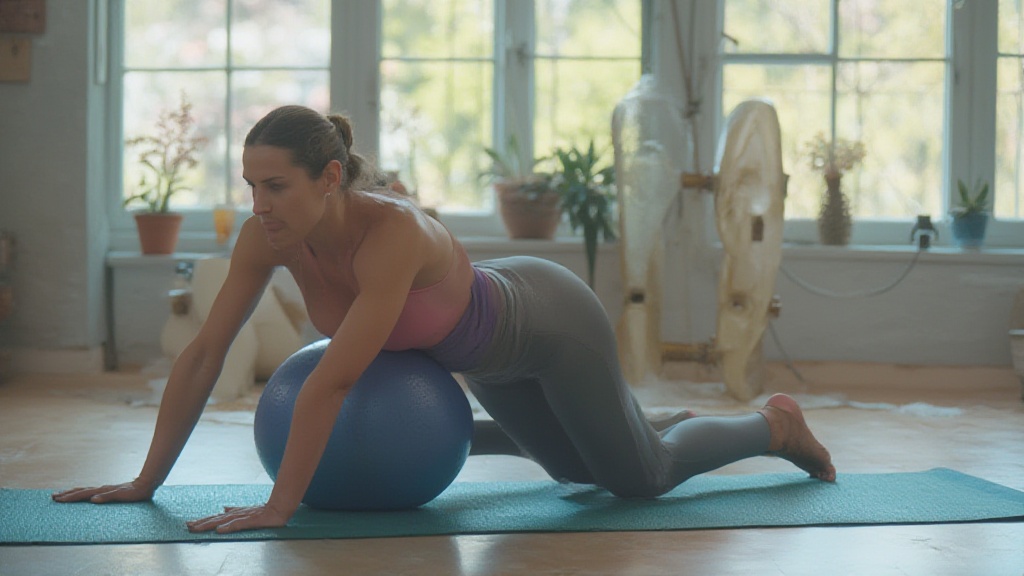
Core stabilization exercises form the basis of a comprehensive fitness routine, essential for enhancing overall strength and performance. Incorporating these exercises not only targets core strength but also promotes muscle engagement throughout your body.
Improved stability facilitates better postural alignment, which is necessary for any athletic pursuit.
As the value of core training becomes more recognized, its popularity continues to increase in gym routines.
Engaging your core during dynamic movements significantly aids in maintaining balance and supports effective execution of various exercise variations, ultimately enhancing your physical conditioning.
Benefits Of Core Strength Training
Developing strong core muscles yields a multitude of advantages that extend beyond gym workouts. For instance, enhanced functional fitness is critical for executing daily activities with efficiency and safety.
Core strength training plays an instrumental role in injury prevention, promoting optimal body mechanics that minimize strain risks, especially in the lower back. A practical application of this concept includes incorporating the plank into your workout plans; this straightforward yet effective exercise improves core engagement and builds muscle endurance.
Enhanced Athletic Performance
Incorporating core training into your routine significantly contributes to improved athletic performance.
As your core muscles strengthen, they provide a stable base for all functional movements, allowing for the effective execution of sport-specific skills.
Stability training also enhances your ability to maintain balance, critical during dynamic activities.
Support for Daily Activities
Core strength is fundamental for executing daily tasks safely and effectively.
Activities such as lifting, bending, and twisting require abdominal strength and pelvic stability to protect your body from injury. Integrating core-focused exercises into your fitness regimen can lead to better postural alignment and improved body awareness.
Practical Example: The Plank
The plank is an excellent example of a core exercise that you can easily integrate into your workout routine.
This exercise targets multiple muscle groups, enhancing core engagement and building endurance while requiring minimal equipment. To perform a plank, follow these steps:
- Begin in a push-up position, with your elbows directly beneath your shoulders.
- Engage your core muscles and keep your body in a straight line from head to heels.
- Hold this position for 15-30 seconds, gradually increasing the duration as your strength improves.
Mastering the plank not only develops your core strength but also supports overall fitness levels, ensuring that you maintain optimal stability and performance during various activities.

How To Improve Stability Training
Optimizing stability training plays a significant role in enhancing athletic performance and reducing injury risks. Stability training improves balance and coordination, which are essential skills across various sports.
To enhance your regimen, incorporate exercises such as single-leg balances and plank variations, both of which can be performed at home or within a gym environment.
Progression is essential; gradually increasing the difficulty of stability exercises promotes muscle activation and bolsters functional fitness.
A systematic approach focusing on controlled movements and correct form will yield the best outcomes.
Essential Abdominal Exercises For Stability
Establishing a strong core is fundamental for enhancing posture and balance, directly impacting overall performance in stability training. Key abdominal exercises include the plank and Russian twists, which effectively strengthen core muscles.
To accommodate different fitness levels, consider the following variations:.
- Plank Variations: Begin with a standard plank, progressing to side planks and elevated planks for increased challenge.
- Russian Twists: Perform these on the floor or with the aid of a stability ball to engage various muscle groups.
- Bird-Dog Exercise: This dynamic movement enhances core engagement and stability, ideal for both beginners and advanced practitioners.
To maximize results in core conditioning, maintaining proper form is essential. Avoid common pitfalls, such as sagging hips or raised shoulders, as these mistakes can diminish effectiveness. Regular engagement in these exercises will yield substantial improvements in overall stability and significantly contribute to injury prevention and functional fitness.
Stability Training
- Studies show that stability training can reduce the risk of injuries by improving overall body control.
- Research indicates that exercises like planks and single-leg balances enhance core strength, leading to better athletic performance.
- Progressive overload in stability training has been linked to increased muscle activation and improved functional fitness.
- Proper form during stability exercises is crucial, as incorrect techniques can lead to ineffective workouts and potential injuries.
What Are Effective Balance Improvement Techniques
Improving balance significantly enhances overall functional fitness. Balance contributes not only to physical performance but also plays an essential role in injury prevention.
Core strength is the foundation of effective balance training, as it targets critical muscle groups responsible for stability.
Incorporating dynamic movements, such as single-leg stands and wobble board exercises, can further challenge and develop stability.
Practices like Tai Chi or Pilates offer progressive techniques that enhance body control and promote core engagement. Tracking progress through tools such as the Berg Balance Test is necessary for recognizing improvements and maintaining motivation in balance improvement.
Incorporating Functional Fitness Into Routines
Enhancing functional fitness leads to improved daily performance and decreased injury risks.
By seamlessly integrating functional movements, including squats with resistance bands and kettlebell exercises, one can elevate existing workout plans. Compound movements not only boost strength but also enhance coordination, which is important for athletic performance.
Implementing a variety of training modalities stimulates multiple muscle groups and adds engagement to workouts.
This approach not only prevents monotony but also fosters long-term commitment to fitness routines, resulting in better overall health and enhanced functionality in daily activities.
| Technique | Benefit |
|---|---|
| Dynamic Movements | Enhances stability and core strength |
| Tai Chi | Improves body control and core engagement |
| Resistance Bands | Increases strength and coordination |
| Berg Balance Test | Tracks progress and maintains motivation |
Injury Prevention Through Core Conditioning
Effective core conditioning significantly aids in reducing the risk of common injuries. Specifically, core strength training enhances the body’s stability, which is essential during both sports and daily activities.
Insufficient strength in the core can lead to various injuries, including lower back pain, hip strains, and knee issues.
Incorporating core stabilization exercises, such as planks, dead bugs, and bridges, can greatly improve core stability.
Maintaining consistency in these exercise routines is important, as regular practice yields long-term benefits, including enhanced injury prevention and improved overall physical health.
Techniques For Enhancing Pelvic Stability
Enhancing pelvic stability contributes directly to overall core strength and functional movement. Implementing targeted techniques can markedly improve pelvic control.
Effective exercises designed for this purpose include pelvic tilts, which activate the pelvic floor and lower back, and bird-dogs, which enhance coordination and stability in these areas. To integrate pelvic stability exercises into daily life, consider the following practical tips:
- Perform pelvic tilts while sitting in a chair, focusing on engaging the core throughout.
- Practice bird-dogs during short breaks to enhance balance and coordination.
- Incorporate these movements into a dedicated short daily routine designed to build stability.
Creating an effective routine that includes these targeted stability exercises can further support injury prevention and enhance overall balance during various activities.
Core Conditioning and Pelvic Stability
- Research shows that strong core muscles can reduce the incidence of lower back pain by up to 50%.
- Studies indicate that individuals who engage in regular core stability exercises experience fewer injuries during athletic activities.
- Improved pelvic stability is linked to better performance in sports that require balance and coordination.
- Consistent practice of core and pelvic exercises can enhance overall functional movement, reducing the risk of falls and related injuries.
How To Use Plank Variations For Core Engagement
Incorporating plank variations into your fitness regimen can significantly enhance core engagement. These versatile exercises effectively target multiple muscle groups, including the abdominal muscles, obliques, and shoulders.
Athletes seeking improved core strength can begin with basic planks and gradually progress to more challenging variations.
Modifying the intensity based on individual fitness levels is essential; beginners may start with the standard plank, while advanced practitioners can explore dynamic movements like the plank with arm or leg lifts.
The Versatility of Plank Variations
Plank variations offer a unique approach to stability training.
By incorporating different angles and movements, you can engage various muscle groups more effectively. For instance, side planks emphasize lateral stability and target the obliques, while the forearm plank focuses on building endurance in the core.
This diversity allows individuals to tailor their workouts to specific fitness goals, ensuring that each session remains challenging.
Progression and Modification Strategies
Progression is a key factor in maximizing the benefits of core conditioning through plank variations. Individuals should assess their fitness levels and implement modifications as needed.
For example, beginners might find success by performing planks on their knees, which reduces the load on the core while building strength.
Advanced practitioners should consider integrating rotational movements or using stability balls to increase difficulty, thereby enhancing muscle activation and improving overall performance.
Incorporating Planks into Your Workout Routine
To effectively include planks in your exercise routines, consider a workout structure that balances static and dynamic movements.
This might involve integrating different plank variations with complementary exercises such as Russian twists or mountain climbers. By strategically designing your core workouts, you can achieve better stability exercises, enhance overall balance, and foster a stronger foundation for athletic performance.
Plank Variations
- Plank variations can enhance core engagement by targeting multiple muscle groups simultaneously.
- Side planks improve lateral stability and are particularly effective for strengthening the obliques.
- Modifying plank positions, such as performing on knees, helps beginners build strength with reduced load.
- Integrating dynamic movements like arm or leg lifts can significantly increase muscle activation during core workouts.
